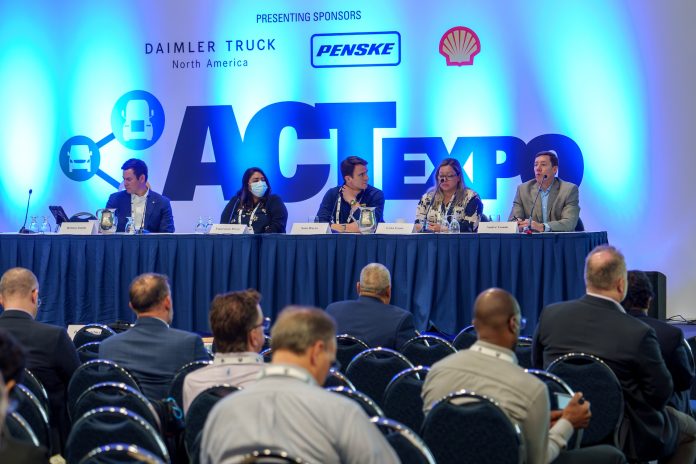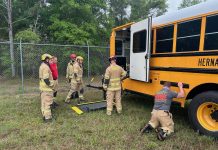ANAHEIM, Calif. — School buses are an ideal application for electric vehicles, commented Britton Smith, the senior vice president of electrification and chief strategy officer for Blue Bird, to commence the electric school bus panel at the ACT Expo.
Smith, who moderated the Wednesday afternoon panel discussion held at the Anaheim Convention Center, added that beside the point that school buses normally don’t travel long trips and report to the same depot, every school bus is also vehicle-to-grid capable.
Also on the panel sat Esperanza Perez, the U.S. Environmental Protection Agency Region 9 school bus lead for California, Nevada and Arizona. She provided an overview of the year-two Clean School Bus Program and a $400 million competitive grant announced last week. She added that the EPA also expects to offer another $600 million rebate program later this year.
Sam Hayes, the chief strategy officer for school transportation contractor Beacon Mobility, also spoke. The company has over 10,000 school buses, vans and other vehicles on the road, operating across 23 states.
Sam Hayes, the chief strategy officer for school transportation contractor Beacon Mobility discussed Beacon’s EV Guiding Principles.
– Electrification of school buses is a “when” not an “if” concept.
– Do the right thing for the environment, our students and the communities we serve.
Maximize the number of EVs in our fleet.
– Get creative to solve the cost problem (e.g. grants, utility and manufacturer relationships, V2G, etc.
– Partner with customers to create a path to electrification.
Hayes added that Beacon has an active electric bus pilot of 10 buses in Massachusetts and hopes to get another 35 more ESBs into operation next year.
Lena Luna, the facility and energy manager at El Monte Union High School District in California, discussed a $9.8 million competitive grant the district received in April 2021 to start its electric school bus journey of 11 vehicles. She noted that the project was supposed to only be a yearlong, but it is now projected to be completed next March.
Luna added that the project is an “experiment,” and the district learned the importance of speaking up about what is working and what isn’t, and what the district needs and wants.
Meanwhile, Andre Gouin, business technology consultant for utility Xcel Energy, announced a program that can help districts electrify school buses in the eight states it covers. He cited the Minnesota Electric School Bus Pilot Program as an example. Gouin noted that Xcel would own about 32 school buses and partner with one or more school bus school districts and their contractors to operate the buses. Xcel also provides power in Colorado, Michigan, New Mexico, North Dakota, South Dakota, Texas, and Wisconsin.
Gouin added that the Minnesota buses will be used to test V2G capability and determine how to maximize the benefits of electric buses to schools and the electric grid. The full-service pilot, he said, is intended to address the barriers of school bus electrification and aims to better understand the costs and benefits of this approach.
Overview of the ESB Market & Future Outlook
Hayes noted that the past one to two years have been a great kickstart to electric school bus adoption, especially with the amount of funding made available from the CSBP. However, he noted that moving from pilot projects to full deployment is decades away, citing internal combustion as still the best choice for certain applications.
Currently, he said, school districts and bus companies need to feel comfortable with ESBs and remove any uncertainty regarding the vehicles. He noted that while the EPA program is a fantastic start, the $1 billion allocated to school districts and companies last year will electrify less than 1 percent of the nation’s total school buses on the road.
He added that state legislation, such as that in New York, will help drive the market. However, he noted that technical assistance barriers to electric school bus adoption remain, and it will be harder for smaller school districts to make the switch. He added that while maintenance costs are lower, the high upfront purchase costs of ESBs are a huge deterrent.
Luna added El Monte Unified used its grant to purchase 11 electric Blue Bird buses outright. The district installed both AC and DC fast chargers, and it stacked grant funds to pay for the infrastructure and charging. She added that battery energy storage installation is at five of the district’s sites.
She noted that grants like the CSBP are not applicable to her district because they require the older diesel buses be scrapped. Luna explained that vehicle range is also a big concern, and the district is unwilling to decommission diesel buses that are needed for longer trips. She added that charging infrastructure will also need to be addressed on a case-by-case basis, and she questioned what will happen to infrastructure used by districts where snowstorms or flooding are common.
Gouin added that he too understands the ESBs are in their early phases, and Xcel can learn a lot from piloting the technology. He noted that the company still needs to determine how the buses will perform in the cold winters.
Luna noted that when setting up the charging infrastructure in El Monte that she was not in favor of adding V2G technology, and the district chose not to pursue the technology. She said she wants the district to reap the full benefits of the batteries and not provide a funding stream for other entities. She advised working closely with service providers and bus dealers to make sure that the ESBs and charging infrastructure voltage match.
She also commented that energy installers are booked in California for the next year or two.
Related: Latest Tally Counts Over 3K Electric School Buses Nationwide
Related: Pennsylvania School District Wins Leading School Fleet at ACT Expo
Related: School Bus, Trucking Markets Brace for Continued Zero-Emissions Funding Tsunami
Related: Update: EPA Announces Latest Clean School Bus Program Grants
Related: Lion Electric Announces School Bus Battery Manufacturing Factory
Gouin agreed, adding that based on the size of the infrastructure, districts could be looking at long lead times, noting that a new transformer could take as long as 18 months to install. He added that when charging, school buses generally have a long dwell time in between routes, or overnight, when they could charge. This could result in lower energy costs and reduce the demand on the grid.
Perez said she hope the future holds more federal funding for school buses, as well as an increase in the amount of funding so that school buses can get electrified faster. Hayes added that there are going to be more mandates from states, and he hopes those mandates aren’t put into place without sufficient funding.
Luna added that once El Monte completes its project, it’s going to take a step back to evaluate how to further optimize operations. She said district officials will also compare CNG, diesel, and electric buses from a financial standpoint.
Technical Breakdowns
When it comes to the technical aspect of operating an electric school bus, Gouin said V2G is very complicated and takes a lot of coordination. He added that today, utilities could pay one amount but less down the road as the grid changes.
He also questioned the second-life of batteries and what will happen to them after they can no longer support school buses and other commercial vehicles.
Luna stated that one of her buses was discharging too quickly, and it turned out a software update was needed. She advised other districts to ensure their buses and chargers are fully updated, similar to cell phone apps.
Meanwhile, Perez said the EPA is looking into issues caused by buses operating in extreme heat or cold, as reports indicate batteries can lose around 17 percent of their charge in extreme cold due to heaters being run. Though, she added, regenerative braking is making up for some of those losses.
Sue Gander, the director of the electric school bus initiative for the World Resources Institute, asked during the Q&A session how the role of training and workplace development will fit into the transition toward electric school buses.
Perez said that is something EPA is investigating. For the CBSP Notice of Funding Opportunity that is open through Aug. 22, she said bus driver and mechanic training is included as an eligible cost. Meanwhile, Hayes added that Beacon’s bus drivers love the vehicles, but mechanics have been slower to accept the adoption.
He noted the latter will start to change when the curriculum is more widely available at trade schools. He added that another aspect is collaborating with the local police and fire to learn how to respond to an ESB involved in a collision or other emergency.
















